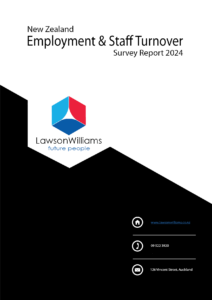New Zealand Staff Turnover Survey
The New Zealand Staff Turnover Survey was established in 2007.
Lawson Williams manages the survey and partners with The Human Resources Institute of New Zealand (HRNZ).
New Zealand Staff Turnover Survey Report – 2024
The latest New Zealand Staff Turnover Report was released in April 2024, providing data from 2007 to 31 December 2023.
The Survey report is presented in two sections.
Section 1 – is available to view and download using this link and provides National Staff Turnover data
Section 2 – is available to participating companies free of charge or can be purchased here
Section 1 contents include
National Staff Turnover – results summary
2024 and beyond – the impact of AI on Staff Turnover
Lifting the lid – Voluntary vs Involuntary Staff Turnover
Staff Turnover in the first 12 months of employment
Common factors that contribute to high first year turnover rate
Staff Turnover in the first 12 months of employment – results summary
Section 2 contents include
National Staff Turnover by Industry Sector
National Staff Turnover Data analysis by Industry
National Staff Turnover by Organisation Type
National Staff Turnover by Organisation Revenue
National Staff Turnover by Organisation Size
National Staff Turnover by Location
Voluntary Staff Turnover by Industry Sector
Top 3 reasons for Voluntary Turnover
Strategies for improving Employee Retention
Involuntary Staff Turnover by Industry Sector
Salary and Benefits – changes in remuneration packages
Flexible Work options
Skills Shortages and Vacancies
Understanding Staff Turnover
Staff Turnover is a measure of employee tenure and the frequency of replacements, and its understanding is critical for any business.
Factors such as industry type, geographic location, job function, and broader social and economic conditions inherently influence a company’s natural turnover rate.
Turnover exceeding this baseline often signals preventable or unexpected losses, which are particularly costly in terms of both financial resources and organisational morale.
In an economic landscape, where competitive pressures mount and talent is in short supply, CEOs are increasingly seeking insights into the turnover trends impacting their operations.
This heightened awareness is driven by the recognition of turnover’s significant costs, which are estimated to range from 100% to 300% of the replaced employee’s base salary.
These costs include:
-
- the expenses associated with hiring and onboarding new staff.
- lost productivity until the new employees reaches full efficiency.
- diminished engagement from other employees witnessing high turnover.
- errors and diminished customer service from newer, less experienced staff.
- the training investments and cultural impacts each departure creates.
Understanding Staff Turnover by Industry sector
The NZ Staff Turnover Survey provides information on a national basis, breaking this down into Voluntary and Involuntary Turnover and considering other factors such as location and company size.
For participants of the survey who receive the full report free of charge the real value of the data is delivered in the breakdown of industry sectors.
It is important for businesses to compare staff turnover rates with others in their industry sector.
Comparing Staff Turnover
When your Staff Turnover is higher than others in your sector it is an opportunity to improve the recruitment, onboarding, retention and development of your people.
In a skills short market lowering your staff turnover results in a reduction in turnover cost and an improvement in performance and organisational culture.
Lower turnover is a competitive advantage. It indicates that you are performing better at recruitment, onboarding, retention and people development.
It can also enable your business to deliver higher productivity and increased profitability.

